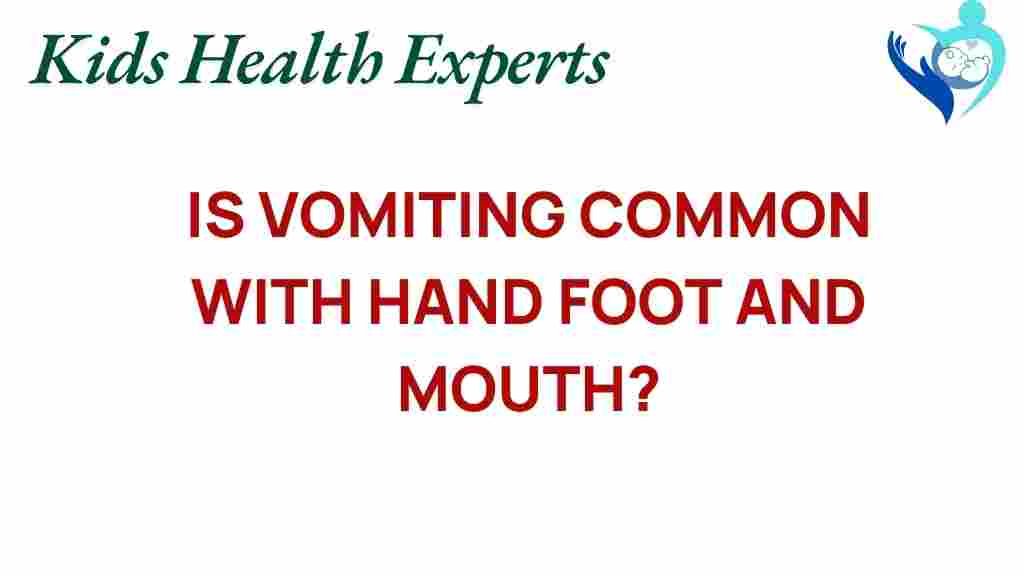Unraveling the Mystery: Is Vomiting Common with Hand, Foot, and Mouth Disease?
Hand, foot, and mouth disease (HFMD) is a viral infection that primarily affects children, causing various symptoms that can sometimes lead to confusion and concern among parents and caregivers. One of the symptoms that often raises questions is vomiting. In this article, we will delve into the relationship between vomiting and hand, foot, and mouth disease, exploring its symptoms, implications for children’s health, and effective illness management strategies.
Understanding Hand, Foot, and Mouth Disease
Hand, foot, and mouth disease is caused by viruses from the enterovirus family, most commonly the coxsackievirus. It is highly contagious and typically spreads through:
- Direct contact with an infected person’s bodily fluids
- Touching contaminated surfaces or objects
- Close personal contact or respiratory droplets
HFMD is most prevalent in children under the age of 5, though older children and adults can also contract the virus. The illness is characterized by a range of symptoms that can vary in severity.
Common Symptoms of Hand, Foot, and Mouth Disease
The symptoms of HFMD usually appear within three to seven days after exposure to the virus. The most common symptoms include:
- Fever: Often the first symptom to appear, indicating the body’s response to the viral infection.
- Skin Rash: Red spots and sometimes painful blisters on the hands, feet, and inside the mouth.
- Mouth Sores: Painful lesions that can make eating and drinking difficult.
- Loss of Appetite: Due to discomfort from mouth sores.
- Fatigue: General feelings of tiredness and malaise.
- Vomiting: While not the most common symptom, it can occasionally occur.
Is Vomiting Common with Hand, Foot, and Mouth Disease?
Vomiting is not one of the primary symptoms associated with hand, foot, and mouth disease. However, it can occur in some cases, particularly when the child is experiencing:
- Severe mouth pain that leads to gagging or choking.
- Fever that may cause discomfort and nausea.
- Dehydration due to reduced fluid intake from mouth sores.
It’s essential for parents to monitor their child’s symptoms closely. If vomiting occurs, it can be a sign of additional complications or the need for medical attention.
When to Seek Medical Care
While hand, foot, and mouth disease is usually mild and self-limiting, there are specific circumstances under which parents should seek pediatric care:
- If vomiting persists or is severe.
- If the child shows signs of dehydration, such as dry mouth, lack of tears, or infrequent urination.
- If the child’s fever exceeds 101°F (38.3°C) and does not respond to fever-reducing medications.
- If the child displays unusual lethargy or irritability.
Prompt evaluation by a healthcare professional can help ensure appropriate care and management.
Managing Symptoms of Hand, Foot, and Mouth Disease
Effective illness management is crucial for children suffering from hand, foot, and mouth disease. Here are some key strategies:
- Hydration: Ensure the child remains hydrated, especially if vomiting occurs. Offer small sips of water, clear broth, or electrolyte solutions.
- Soft Foods: Provide soft, bland foods that are easy to swallow, such as yogurt, applesauce, or mashed potatoes.
- Pain Relief: Use over-the-counter pain relievers such as acetaminophen or ibuprofen to manage fever and discomfort (avoid aspirin in children).
- Rest: Encourage plenty of rest to help the body fight off the viral infection.
- Oral Care: Maintain oral hygiene, but be gentle to avoid irritation of mouth sores.
Preventing the Spread of Hand, Foot, and Mouth Disease
As HFMD is highly contagious, prevention is key, especially in daycare or school settings. Here are some effective prevention strategies:
- Hand Hygiene: Encourage frequent handwashing with soap and water, especially after using the restroom and before eating.
- Disinfect Surfaces: Regularly clean and disinfect toys, doorknobs, and other frequently touched surfaces.
- Avoid Close Contact: Keep sick children at home to prevent the spread of the virus to others.
- Educate Children: Teach children to avoid sharing utensils, cups, and personal items.
By implementing these measures, parents can help reduce the risk of infection in their communities.
Troubleshooting Tips for Parents
If your child is diagnosed with hand, foot, and mouth disease and experiences vomiting or other concerning symptoms, here are some troubleshooting tips:
- Monitor Symptoms: Keep a close eye on your child’s symptoms and note any changes, especially if vomiting occurs.
- Adjust Diet: Modify your child’s diet to include easy-to-digest foods and avoid anything that may irritate mouth sores.
- Stay Calm: Reassure your child and help them stay calm, as anxiety can exacerbate nausea.
- Consult a Pediatrician: If you’re unsure about the severity of the symptoms, don’t hesitate to reach out to your child’s doctor for guidance.
Conclusion
Vomiting is not a common symptom associated with hand, foot, and mouth disease, but it can occur under certain circumstances. Understanding the symptoms of HFMD and how to manage them is essential for the health and well-being of your child. Always consult with a pediatrician if you have concerns about your child’s health or if they exhibit severe symptoms.
For more information on children’s health and viral infections, visit Children’s Health.
By staying informed and taking proactive steps, parents can effectively navigate the challenges of hand, foot, and mouth disease and ensure their child’s health during this contagious illness.
This article is in the category Conditions and created by KidsHealthExperts Team
